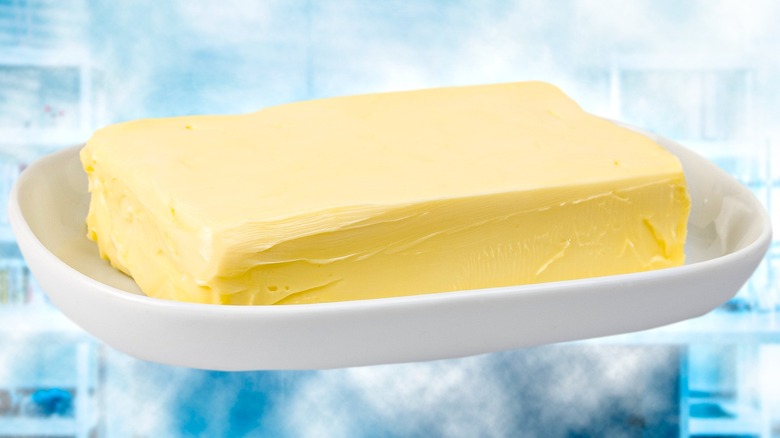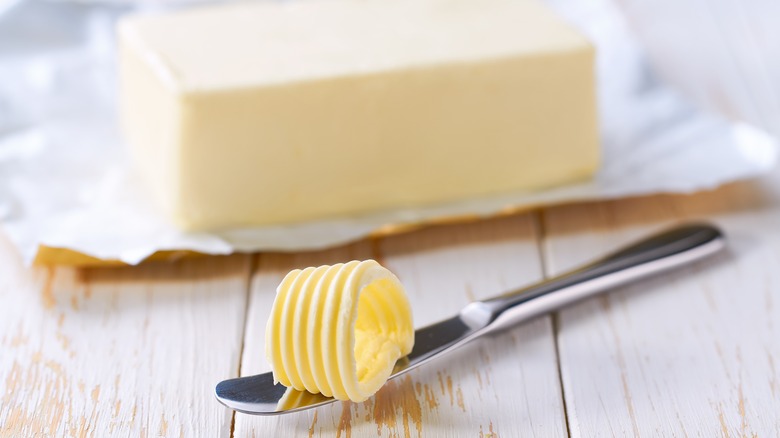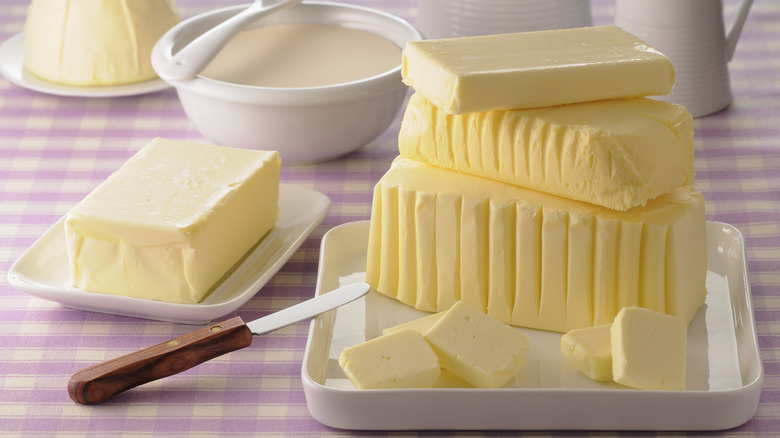This Non-Dairy Butter Is Made From CO2 And Can Help Save The Planet
Be it grass-fed or standard butter, that same stick of buttery goodness you use to enrich your morning pancakes or fluff up your baked goods has a dark side where the environment is concerned. For every kilogram of butter, nearly 17 kilograms of carbon dioxide equivalent is expelled into the atmosphere, according to CarbonCloud. The main culprits are cows, whose milk is used to make butter. These animals produce a lot of methane gas as they digest their food. In fact, the livestock industry as a whole is responsible for about 14.5% of global greenhouse gas emissions, according to the UN's Food and Agriculture Organization.
With the Earth's climate in dire straits, people have been trying to find alternatives to dairy products. Lately, the go-to butter substitute is margarine. Produced from vegetable oil, it's close enough in taste and texture to butter to make for some flavorful and pillowy baked goods when swapped. But even margarine has come under fire lately due to its link to deforestation.
Now, a California start-up called Savor is making waves with an innovative solution: "butter" made from carbon dioxide. It sounds like science fiction or a far-too-ambitious Silicon Valley pitch, but the company is backed by Microsoft founder Bill Gates. So, it really does seem like they have a genuine solution in the works. What's more, Gates himself tried it and gave a rather encouraging verdict: "I couldn't believe that wasn't butter."
How Savor churned butter from thin air
So, how does Savor create a butter-like product without using any animal or plant-based ingredients? Of course, the company isn't going to give out its secret sauce, but people have a general idea about how they managed it. Savor made use of a special thermochemical process that allows the company to build fat molecules from scratch using three ingredients that can be found in the very air we breathe: carbon dioxide, hydrogen, and oxygen.
Savor starts with carbon dioxide, which can be taken from the air by carbon capture or harvested from traditional CO2-emitting sources like municipal wastes. This carbon dioxide is combined with hydrogen in a special chemical reaction known as the Fischer-Tropsch process to transform the mixture into hydrocarbon chains. From there, the hydrocarbons are oxidized into fatty acids. The fatty acids are lastly "seasoned" with some additives to turn them into something that looks and tastes like butter: A bit of water to moisten, an emulsifying agent, beta-carotene to provide more natural color, and — curiously — a touch of rosemary oil for extra flavor.
And there you have it, a butter-like spread made from CO2, with zero animal or plant products involved in the process. While the company keeps the exact details under wraps, they're confident enough in their creation to invite taste testers, and early reviews have been remarkably positive.
Non-dairy fats can help save the planet
There's a reason why Savor made quite a lot of waves in the scientific community when it announced its innovation. Fats created without the involvement of living organisms are considered a key part of a future carbon-free world. If Savor could scale it up, the need for livestock would be reduced, and with that, their huge carbon footprint, too.
It's even more impressive when you look at the numbers provided by Savor on their CO2 butter. Specifically, their butter has a carbon footprint of less than 0.8 grams of CO2 equivalent per calorie. That's less than half the impact of traditional butter, which sits at around 2.4 grams. When compared to plant-based alternatives, the difference is even more striking. Savor's process uses just one-thousandth of the water needed to grow oil crops and takes up no land – just a well-stocked lab will do.
Savor isn't stopping at just butter. There are plenty of other dietary fats that they could swap out using the same recipe. The start-up has said that it plans to make CO2 milk, ice cream, and cheese, as well as plant-free cooking oils. Can the company deliver on that promise? Well, we'll just have to wait and see. But for now, the future sure looks exciting. We're looking forward to making a compound butter for our steaks with CO2 butter!


